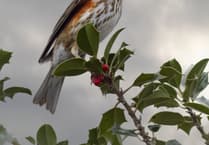
The loud high-pitched buzzing of cicadas is familiar around the Mediterranean, but there are more than 3,000 species of these sound-producing insects, in the family Cicadidae, found in tropical and temperate areas worldwide, from deserts to grasslands to forests.
Each species has a distinct sound but the dominant frequencies these contain are often too high to be detected by people with hearing loss, which happens to most of us by the time we reach middle age.
I was fascinated to learn that a species of cicada, once native to the UK but believed extinct here, is being reintroduced to southern England.
The New Forest Cicada, Cicadetta montana, was found across the New Forest National Park but there were no confirmed sightings since the 1990s, despite efforts by the Species Recovery Trust (SRT).
However, the species is still found in mainland Europe, so a plan was hatched to capture some of them, then start a breeding colony in the New Forest.
The first-of-its-kind reintroduction project is being led by the SRT. Its Lead Project Officer, Charlotte Carne, has kindly allowed us to report on the project.
She said: “It’s a really exciting experiment: the adult cicadas are extremely hard to spot and, although they do sing, it's pretty much impossible to hear the song if you're over 30, so we have to use bat detectors.”
In June this year, SRT imported 11 female New Forest Cicadas that had been collected in France by a specialist entomologist.
Charlotte took delivery of the precious cargo, and took them to their new home, Paultons Park theme park on the edge of the New Forest.
Charlotte, trust director Dom Price and Paultons Park zookeeper Jack Williams, then carefully transferred the cicadas into habitats the zoo team had created with some of the insects’ favourite plants, including raspberry canes and hazel tree saplings.
Charlotte added: “Two days later we were delighted to show our new arrivals to TV presenter Chris Packham, who lives a stone's throw away in the New Forest.
“The day after that was perhaps the most exciting moment: the zoo team at Paultons Park saw the cicadas starting to oviposit – laying eggs in bracken fronds, which they had added to the enclosures.”
Charlotte and the zoo team now have to wait to see if tiny cicada nymphs will hatch out this autumn, fall to the ground and then burrow under the soil where they can feed on the roots of the plants.
“Then it will be an even longer wait: cicadas of this species are believed to spend at least four years underground as nymphs, slowly feeding and growing. If all goes to plan, one day the fully-grown nymphs will tunnel up out of the ground, shed their skins and spread their wings.
“We then hope to make the first ever release of adult cicadas into the New Forest, at secret locations where the habitat is being managed specially for their arrival.
“We hope to import more cicadas from France to continue the captive rearing programme at Paultons Park, so that we can make multiple releases into the forest.”
The project has been funded by Natural England, the Swire Charitable Trust and the Valentine Charitable Trust.
Charlotte added: "This has been a really challenging project so it's amazing to see New Forest Cicadas in England after all this time. It's like bringing them back from the dead!"
.jpeg?width=752&height=500&crop=752:500)
.jpeg?width=209&height=140&crop=209:145,smart&quality=75)



Comments
This article has no comments yet. Be the first to leave a comment.